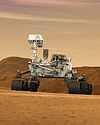Mars 4 |
| Mission type |
Mars orbiter[1] |
|---|
| Operator |
Lavochkin |
|---|
| COSPAR ID |
1973-047A[2] |
|---|
| SATCAT № |
6742[2] |
|---|
|
| Spacecraft properties |
|---|
| Spacecraft |
3MS No.52S |
|---|
| Manufacturer |
Lavochkin |
|---|
|
| Start of mission |
|---|
| Launch date |
21 July 1973, 19:30:59 (1973-07-21UTC19:30:59Z) UTC[3] |
|---|
| Rocket |
Proton-K/D |
|---|
| Launch site |
Baikonur 81/23 |
|---|
|
| End of mission |
|---|
| Last contact |
30 July 1973 (30 July 1973) |
|---|
|
| Orbital parameters |
|---|
| Reference system |
Heliocentric |
|---|
|
| Flyby of Mars (failed orbiter) |
|---|
| Closest approach |
10 February 1974, 15:34 UTC |
|---|
| Distance |
1,844 km (1,146 mi) |
|---|
Mars 4 (Russian: Марс-4), also known as 3MS No.52S was a Soviet spacecraft intended to explore Mars. A 3MS spacecraft launched as part of the Mars programme, it was intended to enter orbit around Mars in 1974. However, computer problems prevented orbital insertion from occurring.
Spacecraft
The Mars 4 spacecraft carried an array of instruments to study Mars. In addition to cameras, it was equipped with a radio telescope, an IR radiometer, multiple photometers, polarimeters, a magnetometer, plasma traps, an electrostatic analyser, a gamma-ray spectrometer, and a radio probe.[4]
Built by Lavochkin, Mars 4 was the first of two 3MS spacecraft launched to Mars in 1973, being followed by Mars 5. A 3MS was also launched during the 1971 launch window as Kosmos 419. However, due to a launch failure, it failed to depart Earth orbit. In addition to the orbiters, two 3MP lander missions, Mars 6 and Mars 7, were launched during the 1973 window.
Launch
Mars 4 was launched by a Proton-K carrier rocket, a Blok D upper stage, flying from Baikonur Cosmodrome Site 81/23.[3] The launch occurred at 19:30:59 UTC on 21 July 1973, with the first three stages placing the spacecraft and upper stage into a low Earth parking orbit before the Blok D fired to propel Mars 4 into heliocentric orbit bound for Mars.
Shortly after performing a course correction on 30 July 1973, two onboard computers failed, leaving Mars 4 unable to perform manoeuvres. As a result of this, it was unable to enter orbit around Mars. A small amount of data was returned as the probe flew past Mars on 10 February 1974, with a closest approach of 1,844 kilometres (1,146 mi) at 15:34 UTC.[4]
References
|
|---|
| | Past | |
|---|
| | Cancelled | |
|---|
| Italics indicate failures at launch. |
|
|
|---|
| Luna 21 ( Lunokhod 2) | Kosmos 543 | Kosmos 544 | Kosmos 545 | Kosmos 546 | Kosmos 547 | Molniya-1 No.31 | Kosmos 548 | Prognoz 3 | Kosmos 549 | Kosmos 550 | Kosmos 551 | OPS 6063 | OPS 8410 | Meteor-M No.29 | Kosmos 552 · Nauka-16KS No.2L | Salyut 2 | Molniya-2-5 | Pioneer 11 | Kosmos 553 | Kosmos 554 | Interkosmos 9 | Anik A2 | Unnamed | Kosmos 555 · Nauka-14KS No.2 | Kosmos 556 | Kosmos 557 | Skylab | OPS 2093 | Kosmos 558 | Kosmos 559 | Unnamed | Kosmos 560 | Unnamed | Skylab 2 | Kosmos 561 · Nauka-9KS No.1 | Meteor-M No.27 | Kosmos 562 | Kosmos 563 | Kosmos 564 · Kosmos 565 · Kosmos 566 · Kosmos 567 · Kosmos 568 · Kosmos 569 · Kosmos 570 · Kosmos 571 | Kosmos 572 | Explorer 49 | OPS 6157 | Kosmos 573 | Kosmos 574 | Kosmos 575 | OPS 4018 | Kosmos 576 | Unnamed | Molniya-2-6 | OPS 8261 | ITOS-E | Mars 4 | Kosmos 577 | Mars 5 | Skylab 3 | Kosmos 578 | Mars 6 | Mars 7 | OPS 8364 | Kosmos 579 | OPS 7724 | Kosmos 580 | Intelsat IV F-7 | Kosmos 581 | Kosmos 582 | Molniya-1-24 | Kosmos 583 | Kosmos 584 | Kosmos 585 | Kosmos 586 | Unnamed | Kosmos 587 | Soyuz 12 | OPS 6275 | Kosmos 588 · Kosmos 589 · Kosmos 590 · Kosmos 591 · Kosmos 592 · Kosmos 593 · Kosmos 594 · Kosmos 595 | Kosmos 596 | Kosmos 597 | Kosmos 598 | Kosmos 599 | Kosmos 600 | Kosmos 601 | Molniya-2-7 | Kosmos 602 | Explorer 50 | Kosmos 603 | Kosmos 604 | Transit-O 20 | Interkosmos 10 | Kosmos 605 | Kosmos 606 | Mariner 10 | NOAA-3 | Kosmos 607 | OPS 6630 · OPS 6630/2 · OPS 7705 | Molniya-1 No.32 | Skylab 4 | Kosmos 608 | Kosmos 609 | Kosmos 610 | Kosmos 611 | Kosmos 612 | Kosmos 613 | Molniya-1-26 | Kosmos 614 | Kosmos 615 | OPS 9433 · OPS 9434 | Explorer 51 | Kosmos 616 | Soyuz 13 | Kosmos 617 · Kosmos 618 · Kosmos 619 · Kosmos 620 · Kosmos 621 · Kosmos 622 · Kosmos 623 · Kosmos 624 | Kosmos 625 | Molniya-2-8 | Oreol 2 | Kosmos 626 | Kosmos 627 | | Payloads are separated by bullets ( · ), launches by pipes ( | ). Manned flights are indicated in bold text. Uncatalogued launch failures are listed in italics. Payloads deployed from other spacecraft are denoted in (brackets). |
|
|
|---|
| | Current | | |
|---|
| | Past | |
|---|
| | Planned | |
|---|
| | Proposed | |
|---|
| Cancelled
concepts | |
|---|
| Italics indicate failures at launch. |
|

